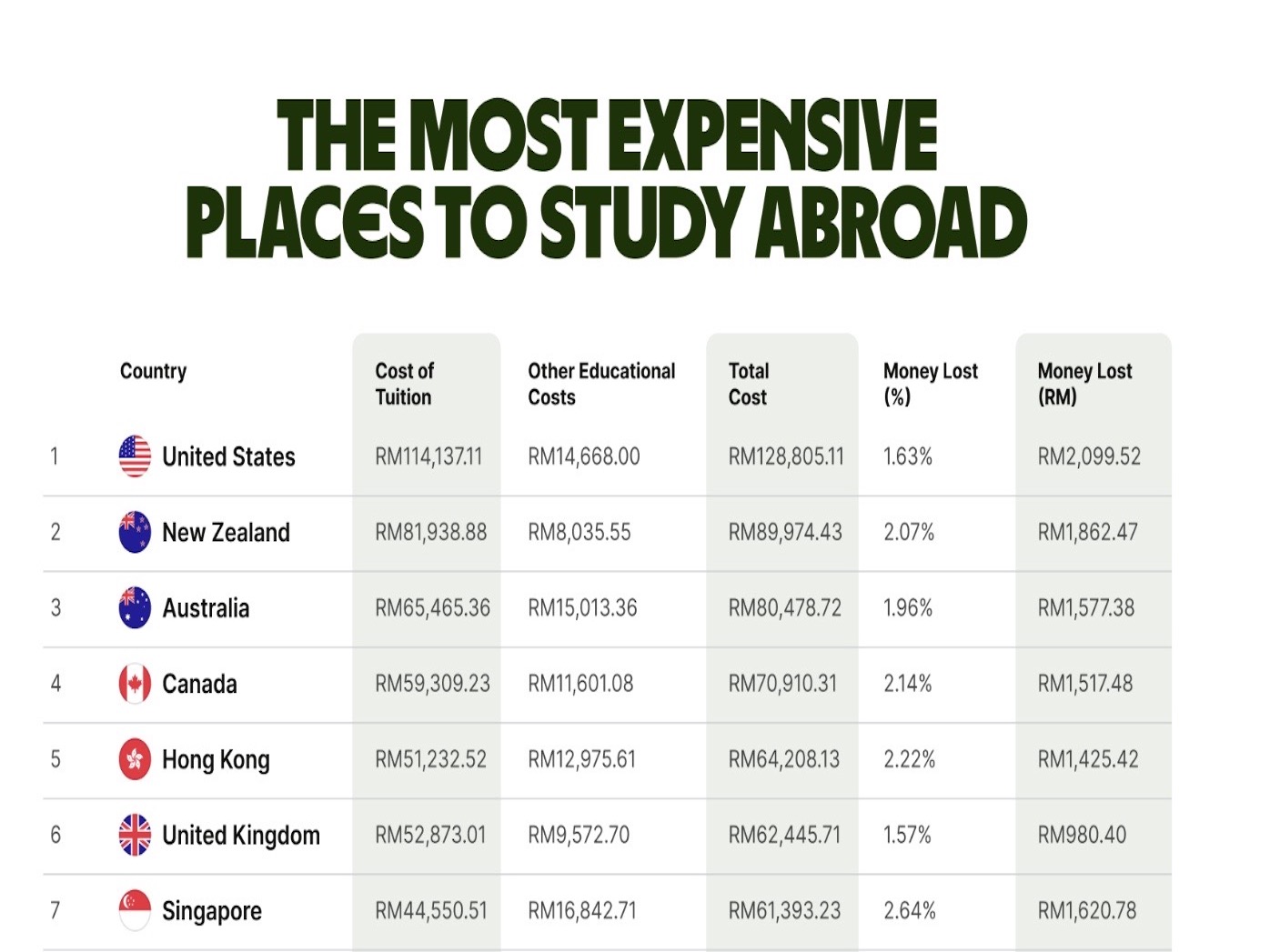As more Malaysian students set their sights on furthering their education overseas, the amount of money they will need to spend while studying abroad is a key consideration. Tuition fees, other educational costs and living expenses are not the only costs that should be factored in – according to new research from global technology company Wise, international students are losing money in foreign exchange fees each year.
The new study found that Malaysian students studying overseas overpay approximately MYR 69.9 million in total transfer fees every year. With close to 60,000 Malaysians studying internationally, this is an average of MYR 1,182.92 lost annually per student from transfer-related fees – which often include hidden fees in marked-up exchange rates charged by most traditional providers.
The research ranked the 10 most expensive destinations to study abroad, both in terms of tuition costs and money lost to hidden fees, and found international students globally overpay approximately MYR 5.3 billion annually in hidden transfer fees when moving money across borders.
Malaysian students studying in Singapore lose the most in transfer fees

According to internal Wise data, Malaysian students studying abroad spend the most money on education in the US, with an average of MYR 130,470.38 spent per year – even higher than the global average.
Australia and the United Kingdom – both in the top five education destinations for Malaysian students – are also expensive countries to study in, with the annual costs averaging between MYR 65,665.04 to MYR 77,221.40 annually. Singapore, the closest international destination surveyed, proved to be the most costly in transfer fees, with students losing MYR 3,719.17 on average every year.
The United States, New Zealand and Australia: The top 3 most expensive places to study abroad globally

Of the destinations surveyed, the United States was the most expensive place to study abroad globally, costing 35 per cent more than the next most expensive location on the list. On top of hefty educational costs (an average of MYR 128,805.11 per school year), international students in the US paid an average of MYR 2,099 each on transfer fees alone every year.
Lim Paik Wan, Country Manager, Malaysia at Wise, said: “The recent release of the SPM results has likely sparked discussions among many students and their families about the possibility of studying abroad. There are a number of factors to take into account, from the quality of the programmes on offer, to the cost of living and tuition. At Wise, we make it easy for people to send, spend and receive money like a local in over 40 currencies with our account and card. We pride ourselves on transparency and fair pricing by using the mid-market exchange rate – the one you see on Google – and state all fees clearly for every transaction. Over the course of a degree, this can account for hundreds, if not thousands, of ringgit in savings.”
Three tips to managing money wisely when studying abroad
The large amount of financial investment required for studying abroad can be daunting for many aspiring students. Amid the rising cost of living and high inflation, students and their families can look to smarter money management to ensure they are making the most of their money during their studies abroad.
Here are a few simple ways students can get a head start on saving more and managing their finances wisely:
- Watch out for hidden fees: The first thing to check when moving money internationally is the total cost, which includes both the upfront fee and exchange rate. The upfront fee may be advertised as low or even “free”, but be aware that it may not represent the actual total cost. Hidden fees can lie in the exchange rate, where providers tend to add an undisclosed markup instead of using the mid-market exchange rate. This practice leads to many people unknowingly paying more than they should. With international students losing millions in transfer fees every year, it’s important to look closely at the exchange rate and fees to know exactly how much they are actually paying to send, spend or receive money internationally.
- Think local: Don’t rely solely on your traditional credit or debit card from home while living overseas, as conversion rates and foreign transaction fees will rack up quickly over time. Students are often advised to set up local bank accounts for this reason, though this can only happen after they’re settled in, as traditional banks require a local address and other documentation. Alternatively, consider an option like the Wise account which allows people to get account details in multiple currencies without needing a local address so they can manage their money easily no matter their location. It also comes with a debit card to spend worldwide with no hidden fees.
- Make use of student discounts: Never underestimate the benefits of student-only offers and loyalty programs. From the coffee shop on campus to grocery stores and cinemas to transit passes, making a habit of checking for any available student deals can net significant savings in the long run

Source: Wise
